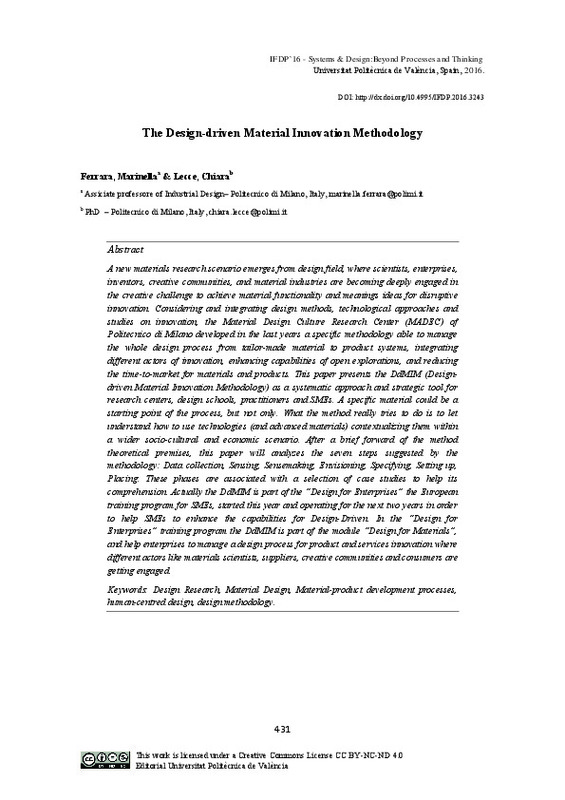JavaScript is disabled for your browser. Some features of this site may not work without it.
Buscar en RiuNet
Listar
Mi cuenta
Estadísticas
Ayuda RiuNet
Admin. UPV
The Design-driven Material Innovation Methodology
Mostrar el registro sencillo del ítem
Ficheros en el ítem
| dc.contributor.author | Lecce, Chiara
|
es_ES |
| dc.contributor.author | Ferrara, Marinella
|
es_ES |
| dc.date.accessioned | 2017-09-20T06:35:57Z | |
| dc.date.available | 2017-09-20T06:35:57Z | |
| dc.date.issued | 2016-10-27 | |
| dc.identifier.isbn | 9788490484401 | |
| dc.identifier.uri | http://hdl.handle.net/10251/87558 | |
| dc.description.abstract | [EN] A new materials research scenario emerges from design field, where scientists, enterprises, inventors, creative communities, and material industries are becoming deeply engaged in the creative challenge to achieve material functionality and meanings ideas for disruptive innovation. Considering and integrating design methods, technological approaches and studies on innovation, the Material Design Culture Research Center (MADEC) of Politecnico di Milano developed in the last years a specific methodology able to manage the whole design process from tailor-made material to product systems, integrating different actors of innovation, enhancing capabilities of open explorations, and reducing the time-to-market for materials and products. This paper presents the DdMIM (Designdriven Material Innovation Methodology) as a systematic approach and strategic tool for research centers, design schools, practitioners and SMEs. A specific material could be a starting point of the process, but not only. What the method really tries to do is to let understand how to use technologies (and advanced materials) contextualizing them within a wider socio-cultural and economic scenario. After a brief forward of the method theoretical premises, this paper will analyzes the seven steps suggested by the methodology: Data collection, Sensing, Sensemaking, Envisioning, Specifying, Setting up, Placing. These phases are associated with a selection of case studies to help its comprehension. Actually the DdMIM is part of the “Design for Enterprises” the European training program for SMEs, started this year and operating for the next two years in order to help SMEs to enhance the capabilities for Design-Driven. In the “Design for Enterprises” training program the DdMIM is part of the module “Design for Materials”, and help enterprises to manage a design process for product and services innovation where different actors like materials scientists, suppliers, creative communities and consumers are getting engaged. | es_ES |
| dc.format.extent | 18 | es_ES |
| dc.language | Español | es_ES |
| dc.publisher | Editorial Universitat Politècnica de València | es_ES |
| dc.relation.ispartof | Systems&design:beyond processes and thinking | es_ES |
| dc.rights | Reconocimiento - No comercial - Sin obra derivada (by-nc-nd) | es_ES |
| dc.subject | Design Research | es_ES |
| dc.subject | Material-product development processes | es_ES |
| dc.subject | Human-centred design | es_ES |
| dc.subject | Design methodology | es_ES |
| dc.title | The Design-driven Material Innovation Methodology | es_ES |
| dc.type | Capítulo de libro | es_ES |
| dc.type | Comunicación en congreso | es_ES |
| dc.identifier.doi | 10.4995/IFDP.2015.3243 | |
| dc.rights.accessRights | Abierto | es_ES |
| dc.description.bibliographicCitation | Lecce, C.; Ferrara, M. (2016). The Design-driven Material Innovation Methodology. En Systems&design:beyond processes and thinking. Editorial Universitat Politècnica de València. 431-448. https://doi.org/10.4995/IFDP.2015.3243 | es_ES |
| dc.description.accrualMethod | OCS | es_ES |
| dc.relation.conferencename | Systems & Design: Beyond Processes and Thinking | es_ES |
| dc.relation.conferencedate | June 22-24,2016 | es_ES |
| dc.relation.conferenceplace | Valencia, Spain | es_ES |
| dc.relation.publisherversion | http://ocs.editorial.upv.es/index.php/IFDP/IFDP/paper/view/3243 | es_ES |
| dc.description.upvformatpinicio | 431 | es_ES |
| dc.description.upvformatpfin | 448 | es_ES |
| dc.type.version | info:eu-repo/semantics/publishedVersion | es_ES |
| dc.relation.pasarela | OCS\3243 | es_ES |








